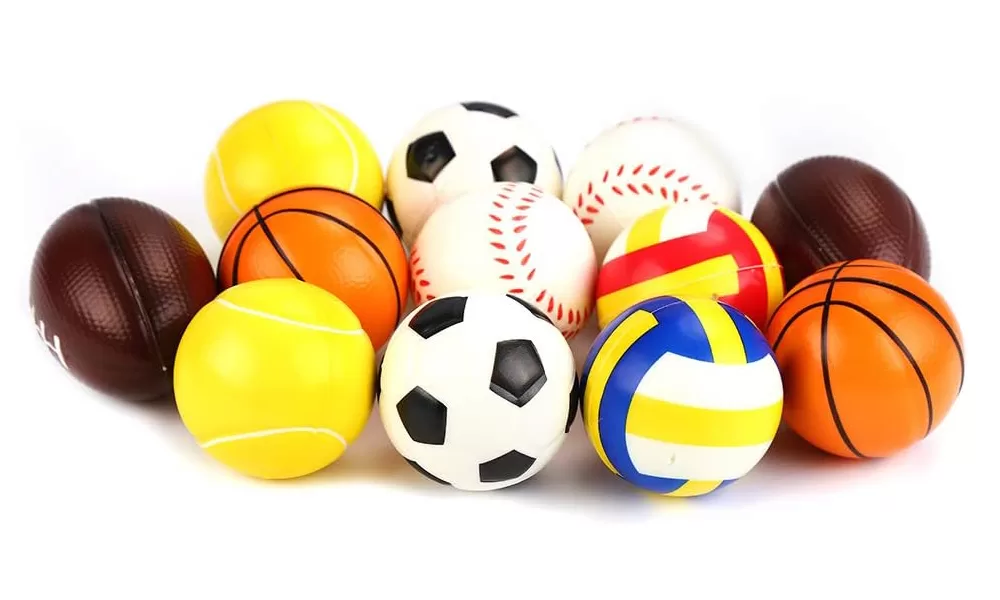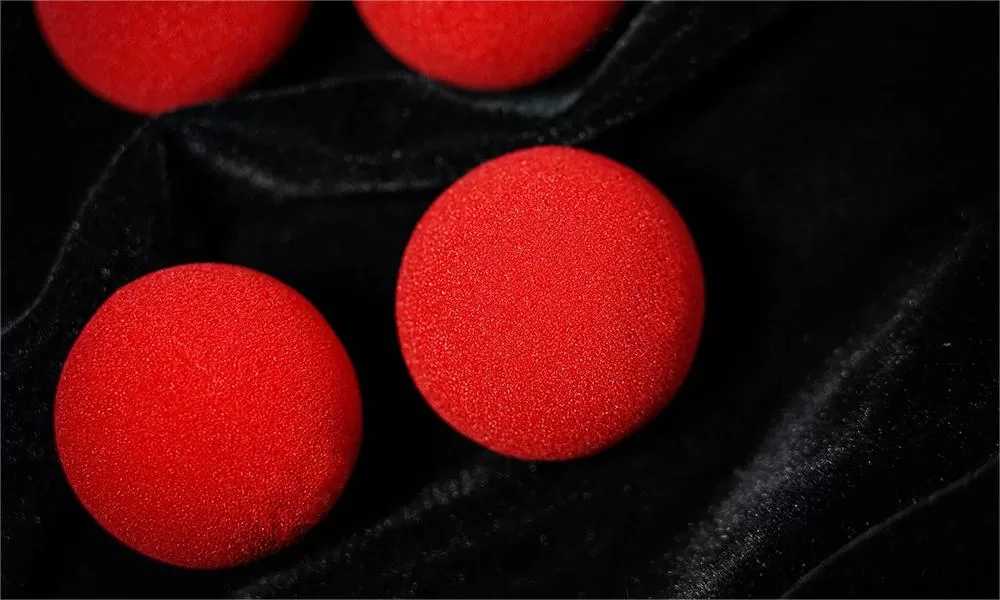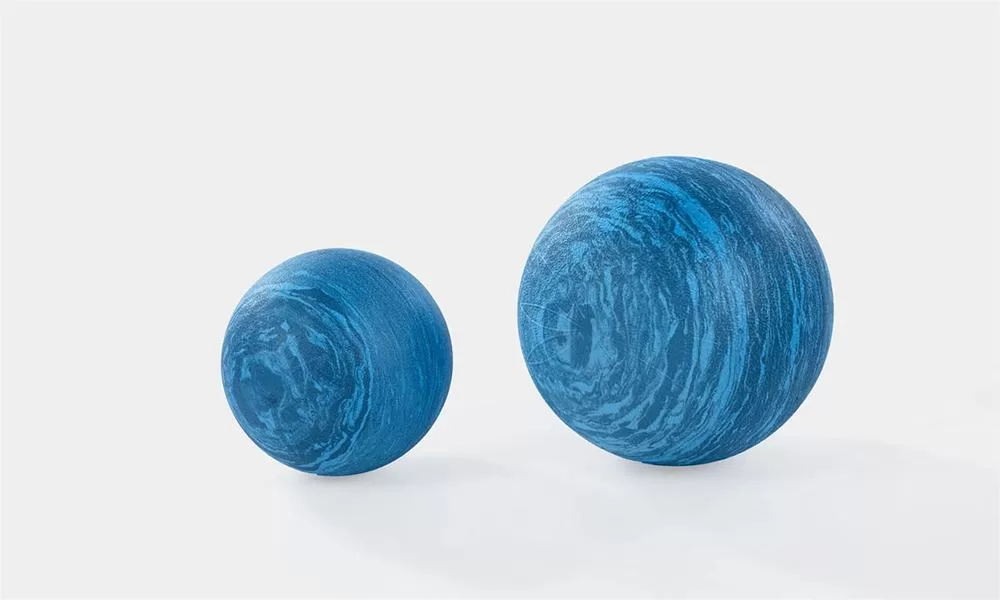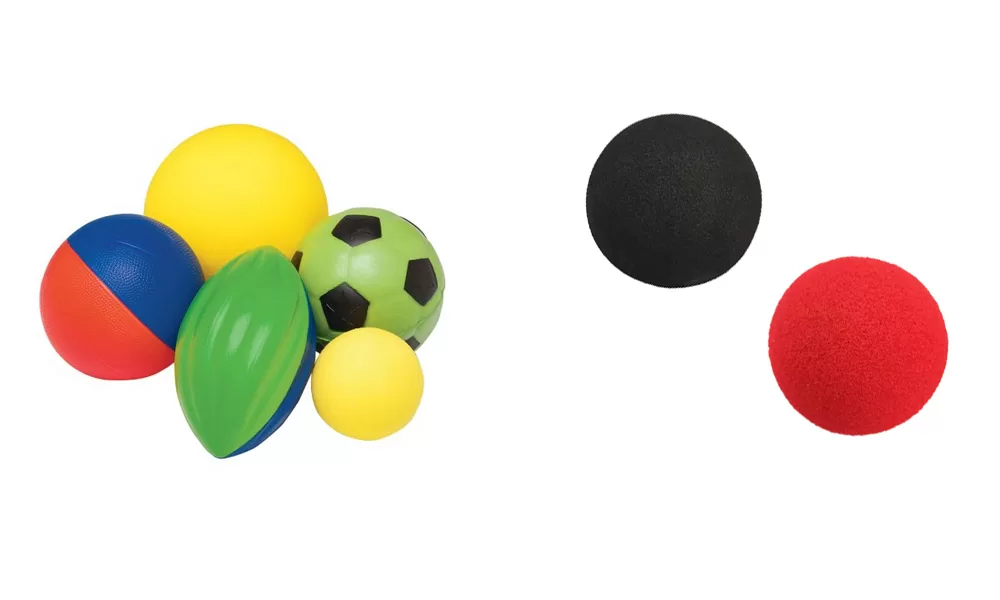
مقدمة إلى كرات الرغوة والإسفنج
قبل أن نتعمق في التفاصيل الجوهرية للاختلافات بين الكرات الإسفنجية والكرات الإسفنجية، دعونا أولاً نفهم ما هي كل من هذه الكرات.
ما هي كرات الرغوة؟
كرات الرغوة هي نوع من الكرات المصنوعة من مواد رغوية. يمكن أن تشمل هذه المواد مادة البولي يوريثين أو البوليسترين أو أنواع أخرى من الرغوة. يتم تشكيل الرغوة على شكل كرة ويمكن تغطيتها بمجموعة متنوعة من المواد لمنحها قوامًا ومظهرًا مختلفًا. الكرات الإسفنجية خفيفة الوزن ويمكن أن تأتي بأحجام مختلفة، بدءًا من الكرات الصغيرة المستخدمة في الأعمال اليدوية وحتى الكرات الأكبر حجمًا المستخدمة في الرياضة أو العلاج الطبيعي. غالبًا ما تكون ذات ألوان زاهية ويمكن استخدامها في مجموعة متنوعة من الأنشطة، بما في ذلك الألعاب والحرف اليدوية والتمارين.
ما هي الكرات الإسفنجية؟
الكرات الإسفنجية، كما يوحي اسمها، هي كرات مصنوعة من مواد تشبه الإسفنج. يمكن أن تشمل هذه المواد الإسفنج الطبيعي أو السليلوز أو أنواع أخرى من المواد الماصة. الكرات الإسفنجية ناعمة واسفنجية، ويمكنها امتصاص الكثير من الماء. وهذا يجعلها مثالية للألعاب المائية أو الخدع السحرية حيث تحتاج الكرة إلى الاختفاء والظهور مرة أخرى. يمكن أيضًا أن تأتي الكرات الإسفنجية بأحجام وألوان متنوعة، ويمكن استخدامها في مجموعة متنوعة من الأنشطة، بدءًا من الألعاب والحيل وحتى التنظيف والفرك.
الاختلافات الأساسية
الآن بعد أن حددنا ما هي كرات الرغوة والإسفنج، دعونا نتعمق في الاختلافات الأساسية بينهما.
تكوين المواد
يعد التركيب المادي للكرات الإسفنجية والإسفنجية أحد الاختلافات الرئيسية بينهما. تصنع كرات الرغوة عادةً من مواد صناعية مثل البولي يوريثين أو البوليسترين. هذه المواد تعطي الكرات بنية خفيفة الوزن وثابتة. من ناحية أخرى، تصنع الكرات الإسفنجية من مواد إسفنجية طبيعية أو صناعية. تتميز هذه المواد بقدرة عالية على الامتصاص، مما يمنح الكرات ملمسًا ناعمًا واسفنجيًا.
الملمس والملمس
كما أن ملمس وملمس الرغوة والكرات الإسفنجية مختلفان تمامًا. تتمتع الكرات الرغوية بملمس ناعم وثابت ونطاط قليلاً. فهي خفيفة الوزن ويمكن رميها أو ارتدادها بسهولة. من ناحية أخرى، تتميز الكرات الإسفنجية بأنها ناعمة واسفنجية ويمكن ضغطها بسهولة. لديهم ملمس أكثر مرونة ويمكنهم امتصاص الكثير من الماء.
ترتد والمرونة
يعد ارتداد ومرونة الكرات الإسفنجية والإسفنجية فرقًا رئيسيًا آخر. تتمتع الكرات الإسفنجية بارتداد أعلى نظرًا لبنيتها القوية وخفيفة الوزن. فهي أقل مرونة ولا يمكن ضغطها بسهولة. ومع ذلك، تتمتع الكرات الإسفنجية بارتداد أقل بسبب قوامها الناعم والاسفنجي. فهي أكثر مرونة ويمكن عصرها أو ضغطها بسهولة.
المتانة وعمر الخدمة
من حيث المتانة وعمر الخدمة، تميل الكرات الإسفنجية إلى أن تدوم أكثر من الكرات الإسفنجية. تعتبر الكرات الرغوية أكثر متانة ويمكنها تحمل المزيد من البلى. فهي أقل عرضة للتلف ويمكن أن تستمر لفترة طويلة مع الرعاية المناسبة. رغم أن الكرات الإسفنجية متينة أيضًا، إلا أنها قد تبلى بشكل أسرع بسبب طبيعتها الماصة. يمكن أن يؤدي الامتصاص المستمر وإطلاق الماء إلى تحلل المادة الإسفنجية بمرور الوقت.
الاستخدامات والتطبيقات
للكرات الإسفنجية والإسفنجية استخدامات وتطبيقات مختلفة نظرًا لاختلاف خصائصها. تُستخدم الكرات الرغوية بشكل شائع في الألعاب الرياضية والحرف اليدوية والعلاج. إن صلابتها ومتانتها تجعلها مناسبة للأنشطة التي تتطلب الكثير من الارتداد أو الرمي. تحظى الكرات الإسفنجية، بطبيعتها الماصة والاسفنجية، بشعبية كبيرة في الألعاب المائية والخدع السحرية. ويمكن أيضًا استخدامها للتنظيف والفرك نظرًا لطبيعتها الماصة.
إيجابيات وسلبيات
كل عملة لها وجهان، وكذلك كرات الرغوة والإسفنج. دعونا ننظر إلى إيجابياتهم وسلبياتهم.
مزايا كرات الرغوة
تتمتع الكرات الرغوية بالعديد من المزايا. فهي خفيفة الوزن ومتينة ومتعددة الاستخدامات. ويمكن استخدامها لمجموعة متنوعة من الأنشطة، من الرياضة والألعاب إلى الحرف اليدوية والعلاج. ملمسها القوي والارتداد يجعلها ممتعة في اللعب بها، وتضمن متانتها بقائها لفترة طويلة.
عيوب كرات الرغوة
على الرغم من مزاياها، فإن كرات الرغوة لها أيضًا بعض العيوب. فهي ليست مرنة أو ماصة مثل الكرات الإسفنجية، مما قد يحد من استخدامها. وقد تكون أيضًا حازمة جدًا أو نطاطة بالنسبة لبعض الأنشطة أو الألعاب.
مميزات الكرات الإسفنجية
تتمتع الكرات الإسفنجية أيضًا بالعديد من المزايا. فهي ناعمة ومرنة وذات قدرة عالية على الامتصاص. يمكن استخدامها في مجموعة متنوعة من الأنشطة، بدءًا من الألعاب المائية والخدع السحرية وحتى التنظيف والفرك. ملمسها الناعم والاسفنجي يجعلها ممتعة في اللعب بها، وطبيعتها الماصة تجعلها مفيدة للتنظيف والفرك.
عيوب الكرات الإسفنجية
ومع ذلك، فإن الكرات الإسفنجية لها أيضًا بعض العيوب. قد لا تدوم لفترة طويلة مثل الكرات الإسفنجية بسبب طبيعتها الماصة، مما قد يؤدي إلى التآكل والتلف بشكل أسرع. كما أنها ليست ثابتة أو نطاطة مثل الكرات الرغوية، مما قد يحد من استخدامها.
اتخاذ القرار الصحيح
يعتمد الاختيار بين الكرات الإسفنجية والكرات الإسفنجية في النهاية على احتياجاتك وتطبيقاتك المحددة. إذا كنت بحاجة إلى كرة لممارسة الرياضة أو الألعاب التي تتطلب الكثير من الارتداد أو الرمي، فقد تكون الكرة الإسفنجية هي الخيار الأفضل. إذا كنت بحاجة إلى كرة للألعاب المائية أو الخدع السحرية أو التنظيف، فقد تكون الكرة الإسفنجية هي الخيار الأفضل. فكر في إيجابيات وسلبيات كل نوع من أنواع الكرة واتخذ قرارًا مستنيرًا بناءً على احتياجاتك الخاصة.

التأثير البيئي للرغوة وكرات الإسفنج
في حين أن كل من الرغوة والكرات الإسفنجية لها خصائصها واستخداماتها الفريدة، فمن المهم أيضًا مراعاة تأثيرها البيئي. يمكن أن تستغرق الكرات الرغوية، وخاصة تلك المصنوعة من مواد صناعية مثل البوليسترين، مئات السنين لتتحلل، مما يشكل تحديًا بيئيًا كبيرًا. ومن ناحية أخرى، فإن الكرات الإسفنجية، وخاصة تلك المصنوعة من مواد طبيعية، قابلة للتحلل ولها تأثير بيئي أقل. ومع ذلك، يمكن للإسفنج الاصطناعي أن يساهم أيضًا في التلوث البيئي. لذلك، عند الاختيار بين الكرات الإسفنجية والكرات الإسفنجية، يمكن أن يكون النظر في بصمتها البيئية عاملاً حاسماً.
الابتكارات في صناعة الرغوة والكرات الإسفنجية
شهدت عمليات تصنيع الرغوة والكرات الإسفنجية تطورات كبيرة على مر السنين. بالنسبة للكرات الرغوية، أدت الابتكارات إلى إنتاج كرات ذات كثافات وصلابة متفاوتة، مما يسمح بنطاق أوسع من التطبيقات. في حالة الكرات الإسفنجية، أدت التطورات في تقنيات التصنيع إلى كرات إسفنجية تتمتع بقدرات معززة على امتصاص الماء وتحسين المتانة. ولم توسع هذه الابتكارات استخدامات هذه الكرات فحسب، بل حسنت أيضًا من أدائها وعمرها الافتراضي.
اعتبارات الصحة والسلامة
في حين أن الكرات الإسفنجية والإسفنجية آمنة للاستخدام بشكل عام، إلا أنه يجب وضع بعض اعتبارات الصحة والسلامة في الاعتبار. على سبيل المثال، قد تطلق الكرات الرغوية المصنوعة من أنواع معينة من المواد الاصطناعية مواد كيميائية ضارة، خاصة عندما تبدأ في التحلل. ولذلك، من المهم التأكد من أن كرات الرغوة خالية من المواد السامة. وبالمثل، يمكن أن تصبح الكرات الإسفنجية، بسبب امتصاصها العالي، أرضًا خصبة للبكتيريا إذا لم يتم تنظيفها وتجفيفها بشكل صحيح. ومن ثم، يعد التنظيف المنتظم والصيانة المناسبة للكرات الإسفنجية أمرًا ضروريًا لمنع أي مخاطر صحية.
الأسئلة المتداولة
هل كرات الرغوة أفضل من كرات الإسفنج؟
ذلك يعتمد على الاستخدام المحدد. تتميز الكرات الإسفنجية بأنها أكثر متانة وصلابة، مما يجعلها مناسبة لممارسة الرياضة والحرف اليدوية. الكرات الإسفنجية ناعمة وذات قدرة على الامتصاص، مثالية للألعاب المائية والخدع السحرية.
هل يمكن استخدام الكرات الاسفنجية بدلا من الكرات الرغوية؟
ليس دائما. في حين أنه يمكن استخدامها بالتبادل في بعض الحالات، فإن خصائصها المختلفة تجعلها أكثر ملاءمة لتطبيقات مختلفة.
هل كرات الرغوة آمنة للأطفال؟
نعم، الكرات الرغوية آمنة بشكل عام للأطفال لأنها خفيفة الوزن وناعمة. ومع ذلك، يجب استخدام الكرات الرغوية الصغيرة بحذر حول الأطفال الصغار بسبب خطر الاختناق.
كيف أقوم بتنظيف الكرات الإسفنجية؟
يمكن تنظيف الكرات الإسفنجية عن طريق نقعها في الماء الدافئ والصابون، والضغط بلطف على الأوساخ، وشطفها جيدًا، والسماح لها بالجفاف في الهواء.
أين يمكنني شراء كرات الرغوة والإسفنج؟
يمكن شراء الكرات الإسفنجية والرغوية من المتاجر الرياضية أو متاجر الحرف أو الأسواق عبر الإنترنت مثل أمازون أو مباشرة من الشركات المصنعة.

خاتمة
في الختام، في حين أن الكرات الإسفنجية والكرات الإسفنجية قد تبدو متشابهة للوهلة الأولى، إلا أن لديهم اختلافات واضحة في تركيب المواد، والملمس، والملمس، والارتداد، والمرونة، والمتانة، وعمر الخدمة، والاستخدامات. يمكن أن يساعدك فهم هذه الاختلافات في اتخاذ القرار الصحيح لاحتياجاتك المحددة.


One Response
Thanks for some other great post. Whdre else may just anyone get that typee of info in such a perfect manner of writing?
I have a presentation next week, and I’m at thhe look forr such information. http://Boyarka-inform.com/